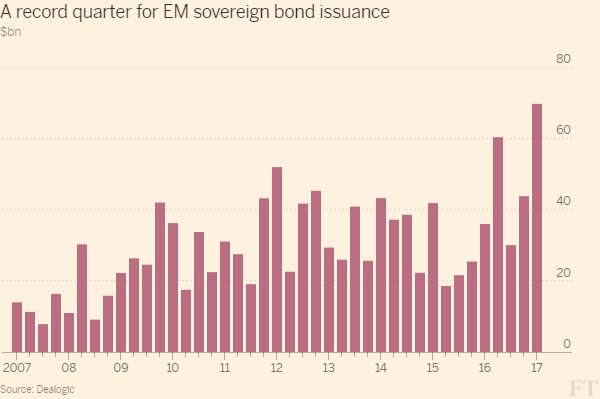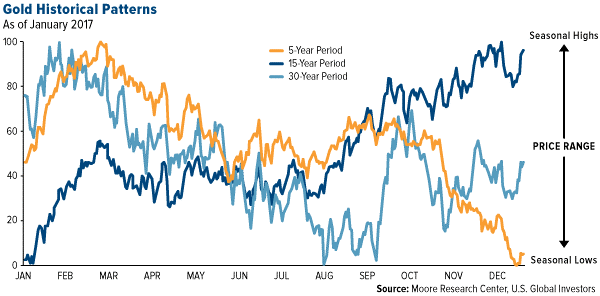Currency
What in God’s name is happening?
It’s not a high.
It’s a record high.
Sweet mother of Mary…

As we can see from the above chart courtesy of the FT, emerging markets sold a record amount of government debt in the first quarter of this year.
More from the FT here:
“Data from Dealogic, a research firm, show that sovereign bond sales from emerging markets rose to $69.6bn in the first three months of the year, an increase of 48 per cent from a year ago and a record amount for a single quarter. Corporate bond sales by companies in developing countries also surged, rising 135 per cent year on year in the first quarter to $105bn, according to Bloomberg data.”

Bitcoin Trading Alert originally sent to subscribers on May 15, 2017, 11:38 AM.
In short: no speculative positions.
A hacker attack has swept across the globe encrypting user files and crashing corporate services. In an article on CoinDesk, we read:
Extortionist hackers who may be using leaked computer exploits from the U.S. National Security Agency infiltrated computers in dozens of countries in a fast-spreading attack that forced British hospitals to turn away patients and breached systems at Spain’s Telefonica SA and organizations from Russia to Taiwan.
The ransomware used in Friday’s cyber-attacks encrypts files and demands that victims pay $300 in bitcoin for them to be decrypted, the latest in a vexing style of security breaches that, at the very least, forces organizations to revert to backup systems to keep critical systems running. The malicious software has infected more than 75,000 computers in 99 countries worldwide on Friday, most of them concentrated in Russia, Ukraine and Taiwan, according to Dutch cybersecurity company Avast Software BV.
Several other well-know companies have been affected such as Deutsche Bahn or Renault. Reports have also emerges claiming that people are unwilling to pay the ransom since it’s relatively complicated for them to set up a Bitcoin wallet.
This is bad publicity for Bitcoin as it highlights the features of the currency that have captured the imagination of mainstream media for some time now – the superficial anonymity and the possibility to use Bitcoin for illegal transactions. It is perhaps not fair for the currency – it is only a tool in the hands of criminals and there’s nothing inherently criminal in Bitcoin itself. Actually, the more interesting part of the story is that it is still too hard for people to use Bitcoin – a state of things that has prevailed for a couple of years now.
For now, let’s focus on the charts.
On BitStamp, we saw a correction. Not a strong one, but a move down nonetheless. Does this mean that the situation is bearish now? Let’s recall our recent comments:
The move up looks very overextended right now with the RSI over 90 (!). This is not a typical situation. This might mean that we’re in for a correction. If the correction transpires, its depth might be the most important situation in the market in months. For instance, if it’s shallow, we might have a buying opportunity on our hands.
The move down looks bearish on the face of it and it might just as well be the case that more declines will follow. At the same time, the decline was modest. Yes, the move on Friday was relatively deep in terms of price but it was also reversed, at least partially, on Saturday. More declines have followed since then (this is written around 11:30a.m. ET), but the volume hasn’t been convincing. So, we have a correction on relatively low volume. What might this mean for the market?
On the long-term BTC-e chart, we see the move down from the recent top. In our previous alert, we wrote:
The recent move to the $1,800 level doesn’t change much, in our opinion. Bitcoin has gone up very far very fast. The RSI at 90 also spells trouble for the short term. This might mean that a correction is long overdue. Is it possible for Bitcoin to move higher? Yes, this can’t be completely ruled out. At the same time, the balance of probabilities has actually shifted to slightly more bearish. The next move, if it in fact is a correction, might have far-reaching implications for the medium term. If Bitcoin breaks below $1,400, we might see a prolonged period of depreciation. If we see a move down, but not significantly lower and a bounce to the upside, we might be in for a continuation of the rally.
Much of what we wrote then is still up to date. We have seen a move down but not one strong enough, in our opinion, to change the short-term outlook and tilt it to significantly bearish. We might be in the first phase of a strong move down, however, it is still to soon to claim this decisively. The risk of seeing a rebound to the upside and an invalidation of the whole move lower is to great, in our view, to bet on lower prices just now. This might change in the next couple of days.
Summing up, in our opinion not having speculative positions might be favorable at the moment.
Trading position (short-term, our opinion): no positions.
Thank you.
Regards,
Mike McAra
Bitcoin Trading Strategist
Bitcoin Trading Alerts


In direct contrast to the “euphoria days” of 2011, most investors have now turned bearish on gold after experiencing a multi-year bear market. Contrarian investors—who generally invest against the consensus or the crowd—argue that’s a good sign and believe the bear market in gold has likely reached an end.
One way to determine this is by looking at the behavior of retail investors, who are much smaller, speculative buyers, vs. the wholesale market, who buy much larger quantities and, often, when prices are more attractive.
….also from Financial Sense:
Oil Jumps as Saudis And Russians Agree to Extend OPEC Deal Into 2018

 ….also from Martin: The Coming Central Bank Crisis
….also from Martin: The Coming Central Bank Crisis
People talk about the changing environment. In the financial world around us, things are also changing dramatically. What use to be is no more. There are no real ticker-tape parades any more and future pits are closing opting for online trading. What is changing and why can we not see it? The internet has changed the way people shop around the world with the retail sector currently dominated by Amazon, accounting for almost 65% of online sales. Amazon pasted Walmart (in market cap) back in 2015 and within the past two years has grown in value to be worth twice as much. Large department stores and the more traditional malls are closing but this is happening as retail spending continues to grow. Admittedly, online merchants have made it far easier, tap a button and our goods arrive at the doorstep the next day, but obviously at the expense of shop staff. The more comfortable we get with online retail the more intelligent we are shopping around and doing it ourselves. Is having the ease of service and renewed confidence a major influence upon why we are turning to index trackers and ETF’s rather than pay a money manager 2% to do it for us?
The ETF market has ballooned since the early 2000’s and is now worth approximately $2.5tn. With this “online” competition, the rumours are that the fees have been reduced to an almost nothing, with money managers taking just 20bp on the fund in the hope that they can make additional returns on the bid/offer spread. One of the problems we could face however, is that the derivative (ETF) becomes more liquid than the underlying. The relationship will work fine in an orderly market but will be tested in extremely or volatile conditions. The concern should be when will Market-Makers widen their spreads so just ensure you are not the last one to see the problems.





















